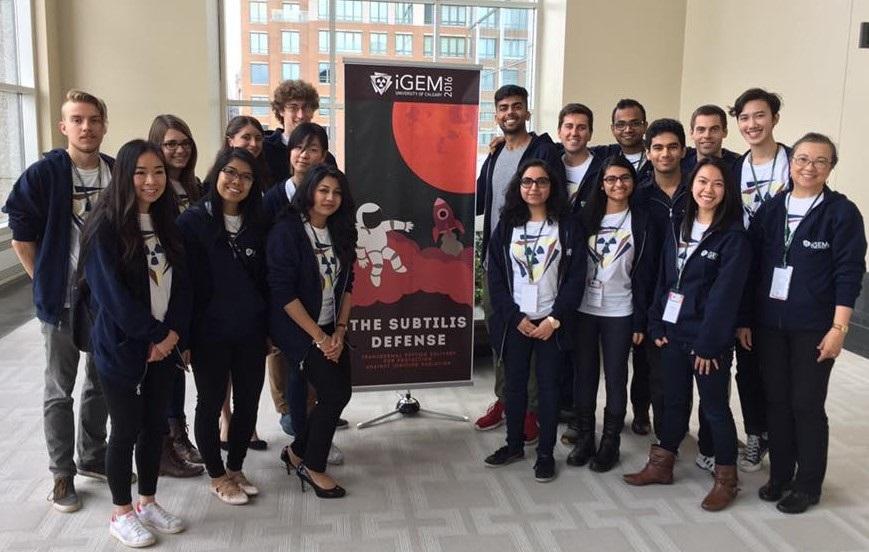Nov. 8, 2016
Undergrad student team brings home gold medal from iGEM Competition

Gold medal iGEM Competition team from the University of Calgary.
Shalpinder Dhothar
While many astronauts aspire to explore deep space and set foot on faraway planets such as Mars, a major barrier in bringing this dream to fruition is exposure to ionizing radiation. Ionizing radiation is abundant in space and has the ability to cause disruptions in DNA structure. This can subsequently lead to either cell death or mutations that can result in cancer.
This year, a group of undergraduate students from the University of Calgary worked on a solution to this problem and developed a non-invasive transdermal patch that delivers radio protective peptides into the body. The group of 15 students just returned from presenting their work at the International Genetically Engineered Machine (iGEM) competition in Boston, an annual synthetic biology competition involving teams from around the world. The team received a gold medal and was nominated for the special award of Best Applied Design in the undergraduate category and won the special award for Best Integrated Human practices in the undergraduate category.
Small patch releases protein to enhance natural DNA repair
The Bowman-Birk Inhibitor (BBI) is a protein that has the capability to enhance the cellular mechanisms responsible for repairing DNA damage. Because astronauts are limited to what they can bring with them on a mission, the team developed a small patch that contains the bacterial chassis Bacillus subtilis which produces and secretes BBI continuously following activation. When the patch is affixed to the skin, BBI is released and travels through the patch, through the skin and into the bloodstream where it can be delivered to cells and enhance natural DNA repair.
“With this project, we hope to provide a sustainable and cost-effective solution to protect astronauts from the effects of ionizing radiation,” says Shalpinder Dhothar, an undergraduate student in the Faculty of Science and iGEM team member. She adds that current methods to protect astronauts include the use of lead shielding or force fields. Both are extremely expensive and can cost as much as $1,000 per pound to take into orbit.
Potential applications far-reaching
Transdermal patches are currently used for a variety of pharmaceuticals such as nicotine patches, contraceptive patches and opioid patches for pain relief. While this patch was developed primarily for use in astronauts, the applications extend far beyond that and could potentially be used to protect those receiving radiation as a treatment for cancer, or in other occupations with high radiation exposure such as pilots, flight attendants and miners.
This year’s University of Calgary iGem team includes undergraduate students representing the Cumming School of Medicine, Schulich School of Engineering and the Faculty of Science. While largely student-led, various faculty members were available to assist the team, with Dr. Mayi Arcellana-Panlilio being largely responsible for working with the students on the challenges of implementing ideas.
“We are very honoured to receive these awards and nominations,” says Dhothar. “It has been an incredibly rewarding experience and a great learning opportunity to participate in iGEM and we hope this project begins a conversation with our university community about the applications of genetic engineering, its safety and potential use in space.”
Biomedical Engineering Calgary provided oversight for the team and was represented by Darren Derksen, PhD, one of three scientific advisers. Anders Nygren, PhD, and Aaron Goodarzi, PhD, also acted as scientific advisers and assisted with the logistics and feasibility of the project. The Robson DNA Science Centre provided people, resources and expertise in both the creation of the concept and the project.
This year’s iGEM mentors:
- Supervisor: Dr. Mayi Arcellana-Panlilio, Cumming School of Medicine
- Advisers:Daniel Ziemianowicz, graduate teaching assistant, Cumming School of Medicine; Nicholas Jette, graduate teaching assistant, Cumming School of Medicine
Front row, from left: Christine Phan, Neliza Mendoza, Noshin Karim, Nishi Patel, Shalpinder Dhothar, Nilesh Sharma, Tiffany Dang, and Dr. Mayi Arcellana-Panlilio. Back row, from left: Daniel Ziemianowicz, Rachelle Varga, Elena Fekete, Miriam Li, James Johnston, Syed Jafri, Nicholas D'Aleo-Sotas, Siddhartha Goutam, Nicholas Jette, David Nguyen.
This year’s iGEM Team (listed as they are pictured above, from left):
Front row:
- Christine Phan, Faculty of Science
- Neliza Mendoza, Schulich School of Engineering
- Noshin Karim, Schulich School of Engineering
- Nishi Patel, Faculty of Science
- Shalpinder Dhothar, Faculty of Science
- Nilesh Sharma, Faculty of Science
- Tiffany Dang, Schulich School of Engineering
Dr. Mayi Arcellana-Panlilio is pictured on the far right.
Back row:
- Rachelle Varga, Faculty of Science.
- Elena Fekete, Faculty of Science
- Miriam Li, Cumming School of Medicine
- James Johnston, Cumming School of Medicine
- Syed Jafri, Cumming School of Medicine
- Nicholas D'Aleo-Sotas, Faculty of Science
- Siddhartha Goutam, Cumming School of Medicine
- David Nguyen, Schulich School of Engineering
Daniel Ziemianowicz is pictured on the far left, while Nicholas Jette is second from the right.
